If you're wondering: "what does a bicycle tune up consist of?", then this list is for you.
Check it out before deciding DIY or bring your bike to a local shop.
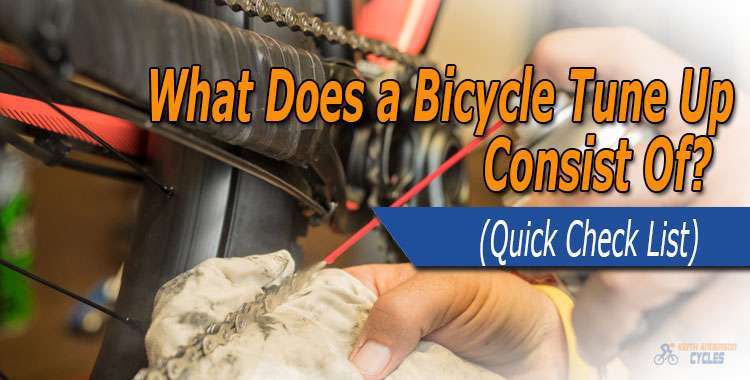
Bike Maintenance 101

It’s important to know when and why to get a tune up in the first place.
After all, a bike is not a car. Cars are complicated pieces of machinery with thousands of parts, and they can go tens of thousands of miles without a hitch.
Although certainly simpler than cars, bikes are deceptively simple, with 100s of parts.
Many of them not designed to take prolonged stress, friction, or road hazards without adjustment or replacement. My bikes actually require more frequent attention than my car.
That a bike’s basic functions work doesn’t mean that it’s healthy.
To illustrate, I bought an early ‘70s Schwinn Suburban a few years ago. Excited by my new purchase, I rode it a few times, and all seemed well.
But further riding and inspection revealed the following:
The goal of a tune up is to make sure that a bike is performing properly and smoothly.
This process helps to prevent larger problems down the road, such as:
A tune up should also extend the life of a bike.
What Does A Bicycle Tune Up Consist Of?

With the first qualifier: it depends.
It depends on how sorry a state your bike is in. A good quality bike purchased the year before and ridden 800 miles should need only the basics.
My Schwinn Suburban was toward the other end of the spectrum.
What does a bike tune up include?
Most local bike shops offer a menu of tune up packages, which might cost from $30 - $150 and up.
The Basic Tune Up:
A basic tune up should include cleaning and lubing the bike, and some minor adjustments.
1. Cleaning the Bike:
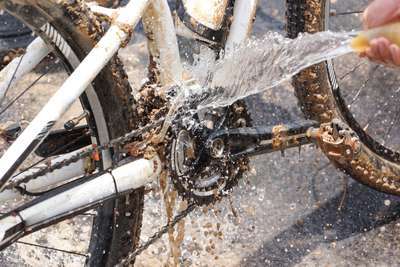
The first step of a simple tune up should be cleaning the bike.
The primary reason to wash a bike is to keep parts clean to reduce wear. Dirt, mud, and grime attach themselves to bikes, especially the drivetrain, getting into parts and mixing with oil.
When washing, the hose pressure should be low as water can seep through cracks undesirably.
Use a mild soap, such as dishwashing soap.
Ideally, use a brush to clean parts like:
These are places where gunk really sticks. A mountain bike will probably have grass mixed in there as well.
After cleaning, lube the chain and moving derailleur parts.
Wipe off the excess. A cheap tune up at a shop may only include wiping down the frame, which is more cosmetic.
2. Adjusting Brakes and Shifting:
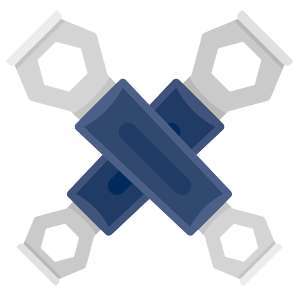
Brakes should be centered and aligned properly. Rubbing disc brakes might be fixable with a simple adjustment.
Also, shifting should be smooth. If, when you shift, the chain doesn’t move but gets stuck in a noisy limbo, then an adjustment may fix the problem.
Going Beyond Basic:
Part of the purpose of a tune up should be to identify problems.
Below, are the most typical maintenance needs that might either:
3. Degreasing:
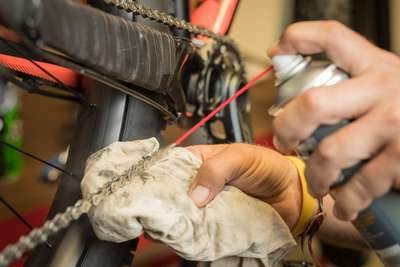
Take the cleaning to another level by degreasing.
Degreasing means you’re removing many of the layers of oil, dirt, and grime that have built up in and around the drivetrain.
You’ll need to buy a degreaser at a bike shop or auto parts store to do this.
A non-toxic and biodegradable degreaser is the best choice. But be careful which one you use since they can be very corrosive and affect the bike’s frame finish.
A degreaser should be applied to most of the drivetrain:
Rinse and re-oil once it’s dry.
4. Drivetrain:
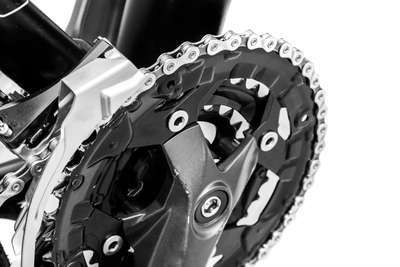
A bike’s drivetrain takes a lot of abuse. A chain, for starters, should be replaced regularly.
They stretch and cause undue stress on the cassette and chainrings.
Casual riders won’t have to do this often, but 1,500 to 2,000 miles on a chain might be enough, depending on conditions.
If you replace the chain frequently enough, then the cassette will last longer. Replacing it yourself requires a chain tool, not a bad tool to own as chains can break while riding.
After the chain is ready to go, make sure it’s lubed.
Replace Derailleur Cables:
Derailleur cables that are frayed or old should be replaced.
You’ll want to regularly replace the plastic housing that the cables go through as well.
Keeping cables and housing in good shape will improve shifting and make broken ones less likely.
Breaking a rear derailleur cable while in action can be enough to end a ride or give you a more serious workout than planned.
Lube parts of the derailleurs that move.
5. Brakes:
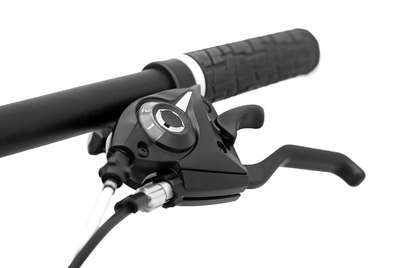
Your stopping mechanisms should be in good working order to keep you from running into cars, chickens, and walls.
Brake cables and housing need to be replaced periodically, but less often than similar derailleur parts.
Brake pads should be replaced if worn.
6. Adjustments:
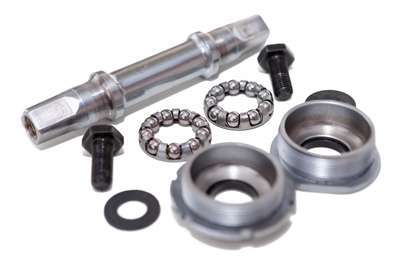
The bike’s headset or bottom bracket may require adjusting.
A loose headset - a common bike ailment - needs, guess what? Tightening!
Before trying, look up the proper procedure for how to do this.
It’s an easy fix to do and diagnose incorrectly.
Bottom bracket maintenance is usually best suited for the pros.
7. Wheels:
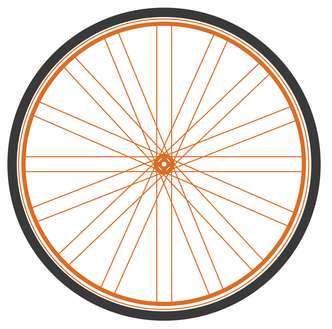
If you don’t carefully inspect your bike on a regular basis, you may never notice problems in the hubs or bearings.
But the hubs may need adjusting and the bearings may need replacement.
A rough feeling when spinning the wheel suggests the bearings are worn. Working with hubs can be easy to challenging depending on the hub.
If you pick up your bike and spin a wheel, looking down at the rim when it passes twelve o’clock.
You can see if the rim is bent or straight:
Truing adequately is not difficult, but it requires a spoke wrench and patience.
A bike shop’s tune up may also include checking spokes for consistent tension.
8. Frame, Rim, Bolt Check:
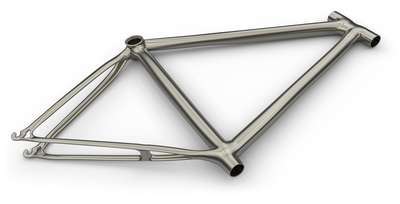
As part of a more extensive tune up, some bike shops may perform a frame and rim inspection to make sure neither has any damage.
Similarly, some tune up packages may include checking every bolt.
Since bike mechanics use torque wrenches when necessary, they are good at not overtightening bolts.
All three types of checks are important for safety.
9. Suspension:
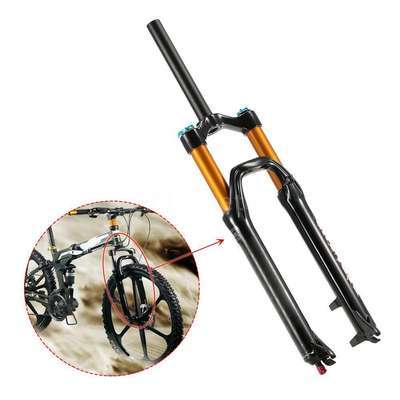
Via Ebay.com
If a bike has suspension, then a tune up should include checking basic settings like pressure and rebound.
If you notice oil on the stanchions, then you’ve succeeded in identifying a shock that needs additional service by a pro.
10. Tires:
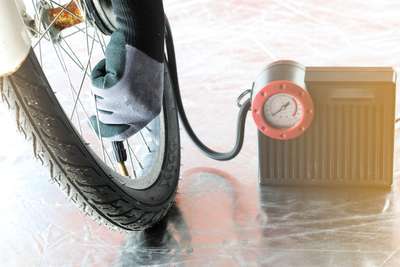
As part of its tune up detail, a bike shop should do a tire check. Personally, I don’t think of tires as being related to a tune up.
Why?
Because you should check your tires regularly to see if they’re too worn or damaged to ride.
Similarly, tire pressure requires more frequent attention as well. In case you neglect these things, add them to the tune up list!
DIY?

The Internet makes home maintenance much easier, and YouTube is a particularly helpful resource.
Out of all the maintenance details mentioned, nearly all can be done by a reasonably competent home mechanic with some basic tools.
Diagnosing what needs to be done when is another matter. Some fixes seem very easy once you get the hang of them, such as truing a wheel.
But if you’ve never done them you may make them worse before better. Trial, error, and patience are important.
The more you ride or the more abusive your rides are the more frequent the tune ups should be.
Unless you want to take your bike to the shop frequently and open the wallet a lot, serious riders should learn how to do some of their own maintenance.
Conclusion:
An out of tune instrument doesn’t sound right. Not sounding right may just be the start of an out of tune bike.
The results of tuning up a bike will be smoother shifting, better braking, more efficient riding, and a more reliable bike.
So, what is the answer to our original question: "what does a bicycle tune up consist of?"
Let me know if I missed any below.

Bike Tune Up is necessary to ensure that your bike’s in optimal shape. However, how much does a bike tune up cost? A basic bike tune-up for as little as $40. You can only enjoy the service for lubricating and basic cleaning. The rate can go as high as $90 if you want a maintenance check and technical repair. If you are looking for a mountain bike tune-up cost, you can upgrade the package to a standard tune-up. You will spend $100 to $160, but your bike will undergo thorough maintenance checks and tune-ups. If your bike needs a major overhaul, it will cost you about $150 to $250. Your bike will be thoroughly checked to know the damage and component issues.
The average cost of a bike tune-up is around $60 to $150. Depending on your bike maintenance needs, you can get either the basic tune-up amounting to $60 or a major tune-up ranging from $100-$150.